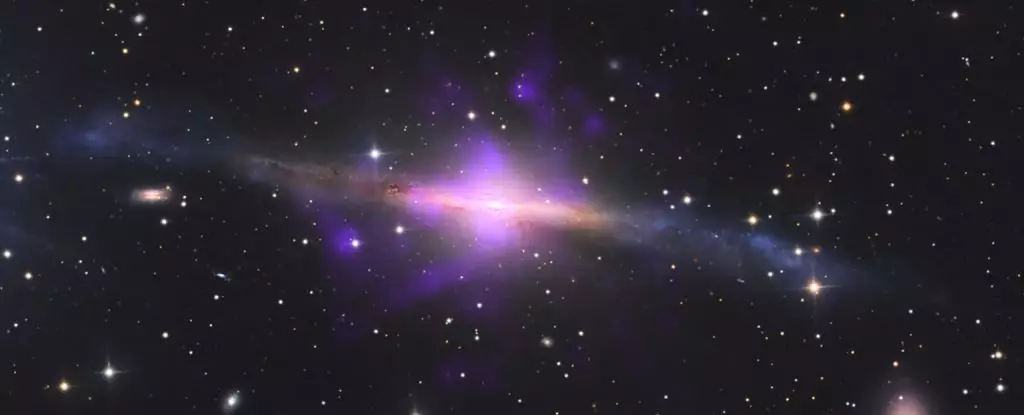NGC 5084, a lenticular galaxy located about 80 million light-years from our Milky Way, has recently taken center stage in astronomical research due to a baffling revelation: its supermassive black hole, typically expected to align with the galaxy’s rotation, is instead skewed on its side. This peculiar orientation challenges existing theories about the formation and behavior of black holes, highlighting the necessity for continual reevaluation of cosmic phenomena. Spurred on by groundbreaking research methods and archival data, astronomers have unearthed a series of findings that depict NGC 5084 as a dynamic entity, with a history that was previously hidden from our view.
Lenticular galaxies, characterized by their disk-shaped structures that lack the pronounced spiral arms seen in spiral galaxies like the Milky Way, occupy a unique niche in the universe. NGC 5084, cataloged by William Herschel in 1785, is not only substantial—with a mass estimated at approximately 1.3 trillion solar masses—but it also possesses a complex nucleus that has been difficult to decipher. The galaxy’s structure presents observational challenges due to its edge-on position and dusty center, making it an excellent target for astronomers keen on understanding supermassive black holes.
Recent advances in imaging technology, particularly applied to historical data from the Chandra X-ray Observatory, facilitated insights into this cosmic enigma. By employing innovative analysis techniques, a team led by astronomer Alejandro Borlaff discerned an enigmatic configuration of four plasma-rich jets emanating from the black hole’s center, laid out in an ‘X’ formation. This discovery ignited questions about the historical dynamics of NGC 5084’s core and the mechanisms that led to such a unique rotational position.
The jets identified suggest intense prior activity surrounding the supermassive black hole, typically a byproduct of mass being consumed and channeled along magnetic lines toward the poles. Interestingly, two jets were found extending vertically above and below the equatorial plane, while the other two were embedded within the galactic disk, indicating a stark divergence from anticipated behavior. This discrepancy led researchers to hypothesize that the black hole may have experienced a substantial event, such as an interaction or merger with another black hole.
Enhanced examination of the galaxy using archival and contemporary observational data from multiple observatories, including the Hubble Space Telescope and the Atacama Large Millimeter/submillimeter Array, revealed additional startling evidence. A band of dust surrounding the black hole was found to be oriented perpendicularly rather than parallel to the galactic plane, suggesting a fundamental tilt—a clear sign of the black hole laying horizontally during recent observations, which supports the theory of a past disruption.
Determining how the black hole acquired this unusual orientation remains a pressing mystery. The evidence points toward a dynamic history potentially framed by gravitational interactions or mergers with other celestial bodies, a process that is echoed across numerous galaxies throughout the universe. The recently measured mass of the black hole, clocking in at an impressive 45.7 million solar masses, adds to the significance of this finding.
While researchers acknowledge the need for further observational campaigns to narrow down the causative events of this cosmic shift, the discovery of two pairs of X-ray jets within one galaxy has already put NGC 5084 on the astrophysical map as a crucial case study for understanding supermassive black holes and their behaviors. Insights gained from this research will not only advance knowledge about NGC 5084 but may also provide critical context regarding the evolutionary pathways of other galaxies and their central black holes.
As a focal point of evolution in galactic dynamics, NGC 5084 provides a lens through which to witness the complexities of cosmic interactions. The unique tilt of its supermassive black hole challenges established paradigms and encourages further probing into the multi-dimensional behavior of galaxies. This research exemplifies the importance of harnessing archival data in revealing the hidden histories of our universe, thereby reminding us that even the most researched celestial bodies can still surprise us. As we continue to unravel these mysteries, NGC 5084 may serve as a key that unlocks deeper understanding about the life cycles of galaxies and the intriguing nature of black holes.

